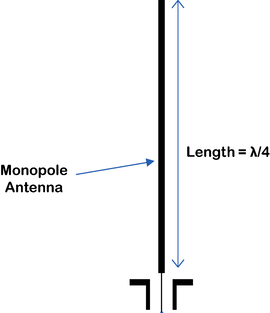How Antennas Receive
This brings us to talking about how to receive signals, and this is where we look at antenna shapes and sizes. As you probably figured out, shapes and sizes of antennas are determined by the frequency and polarization of the signal you’re trying to catch.
Let’s look at how to receive horizontal and vertical polarization first (the simplest). Just like the broadcasting antenna, these are best received by monopole or dipole antennas.


You may notice that the length of the antenna is explicitly depicted in both figures; this is because in both cases, the length of the antenna poles has a specific relationship to the wavelength of the received signal. A monopole antenna will experience the best reception if the antenna is one-quarter the length of the signal wavelength. A dipole, being really nothing more than two monopoles stuck together, will get the best reception if the total length of the antenna (both monopoles measured together) is one-half the signal’s wavelength.
Obviously, the length requirement is not a hard-and-fast rule, otherwise the whip antenna on your car (or the one built into your windshield) would be able to pick up only one station—the one whose signal frequency matched the antenna’s length. Rather, it means that antenna performance will be optimized at a particular length, and if you are designing an antenna to pick up one particular signal, then taking this rule into account will be to your advantage. An interesting experiment for a budding antenna physicist would be to use a handheld FM radio with a variable-length antenna and see if changing the length of the antenna affects the reception of different local stations. Following the equations given earlier, a monopole antenna should be set to about 75 cm to best pick up an FM station transmitting at 100.1 MHz, and making it longer should optimize reception of lower-frequency broadcasts (99.9, for example). Meanwhile, making it shorter (remember, higher frequencies mean shorter wavelengths) should optimize receiving stations at 101.1 and above.
The final antenna shapes that we’ll talk about are those tuned to circularly polarized signals. And what shape is used for that type of reception? Not surprisingly, it hearkens back to the series of antennas mounted circularly around a central mast I mentioned earlier, but in this case it’s more of a DNA shape: the helix antenna.
The simplest helix antenna is the monofilar helix in the image that follows. We don’t want to get too deep into antenna physics, again, so just know that things like the radius of the turns, the distance between them, the total length of the antenna, and the pitch angle affect the reception power. At its core, however, the monofilar helix is just a monopole antenna like the whip antenna we discussed earlier, only with an omnidirectional radiation/reception pattern.

The type of circular polarization of the signal directly affects the shape of the antenna. A helix antenna can be either right- or left-hand polarized, and that polarization must match the signal polarization, otherwise the antenna won’t receive anything. The next step in the antenna complexity stepladder is the double-helical design, which—just as it sounds—imitates the DNA helix and makes the antenna a bit more effective at capturing signals.
Another, more complex antenna design you may find in your antenna design quest is the skew-planar wheel antenna. It’s not used very often—mostly in radio control (RC) designs—but it has the unique characteristic of receiving linearly polarized signals no matter its orientation. It’s why it’s used in RC scenarios; the airplane can still receive signals from the RC transmitter, no matter what direction or orientation it’s in.

Although it’s a pretty interesting design, it’s relatively rare, so I won’t go into it any more here.
